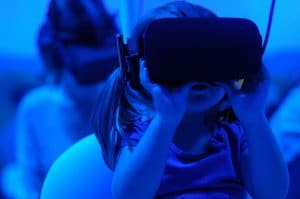Until recently, design has mostly failed the disability community. The growing conversation around inclusivity has led to many breakthroughs in accessible design innovation. An example in the last few years is Ford’s Feel the View, a smart car window that uses image recognition and haptic feedback to open up new experiences for blind users.
According to Architecture & Design, “Technology is increasingly being used to provide visually impaired people a better quality of life by helping them experience and enjoy their immediate surroundings. Feel the View is one such innovation that helps the blind enjoy a great aspect of driving and turn boring journeys into memorable ones… Each image is reproduced in monochrome on the tactile window glass using embedded LEDs. When the passenger touches the glass, the different shades of grey vibrate within a range of 255 intensities, enabling the person to recreate the landscape in their mind. An AI-based voice assistant provides contextual information about the scenery through the vehicle’s audio system.”
Everyone should be able to enjoy the view of a beautiful world that we all share. Imagine using Feel the View to experience the California sunset while traversing the Pacific Coast Highway or to revel in the glory of driving through the Swiss Alps. With Feel the View, not only has accessibility been increased, but a whole new haptic visual language has been created to facilitate the blind’s ability to connect with their reality.
Unfortunately, there are no production plans for Feel the View. In an article for the Cooper Hewitt Smithsonian Design Museum, Walei Subray, the digital accessibility coordinator for the New York City Mayor’s Office for People with Disabilities says, “When products are designed, they have the potential to enable human beings to perform tasks they previously thought were impossible.” Feel the View has no plans for production, and that is where the idea falls short. Subray explains that a design project aiming for inclusivity should “Include people with disabilities from day one. Ask yourself, ‘How many people on the design team are also going to be users?’ ‘Do we have a diverse set of beta testers?’ ‘Have we reached out to the disability community for their feedback throughout the design cycle?’ ‘Have we listened to their feedback?’ It’s all within the basics of good customer service. Because disabled customers are just customers and their money is the same as everyone else’s.”
Read more here.
Reality Changing Observations:
Q1. How could haptic visual language be utilized in video games or other experiences where the blind have previously been excluded?
Q2. Why is it so important for technology to be accessible and inclusive?
Q3. What are you doing in your own sphere of influence to foster inclusivity?





